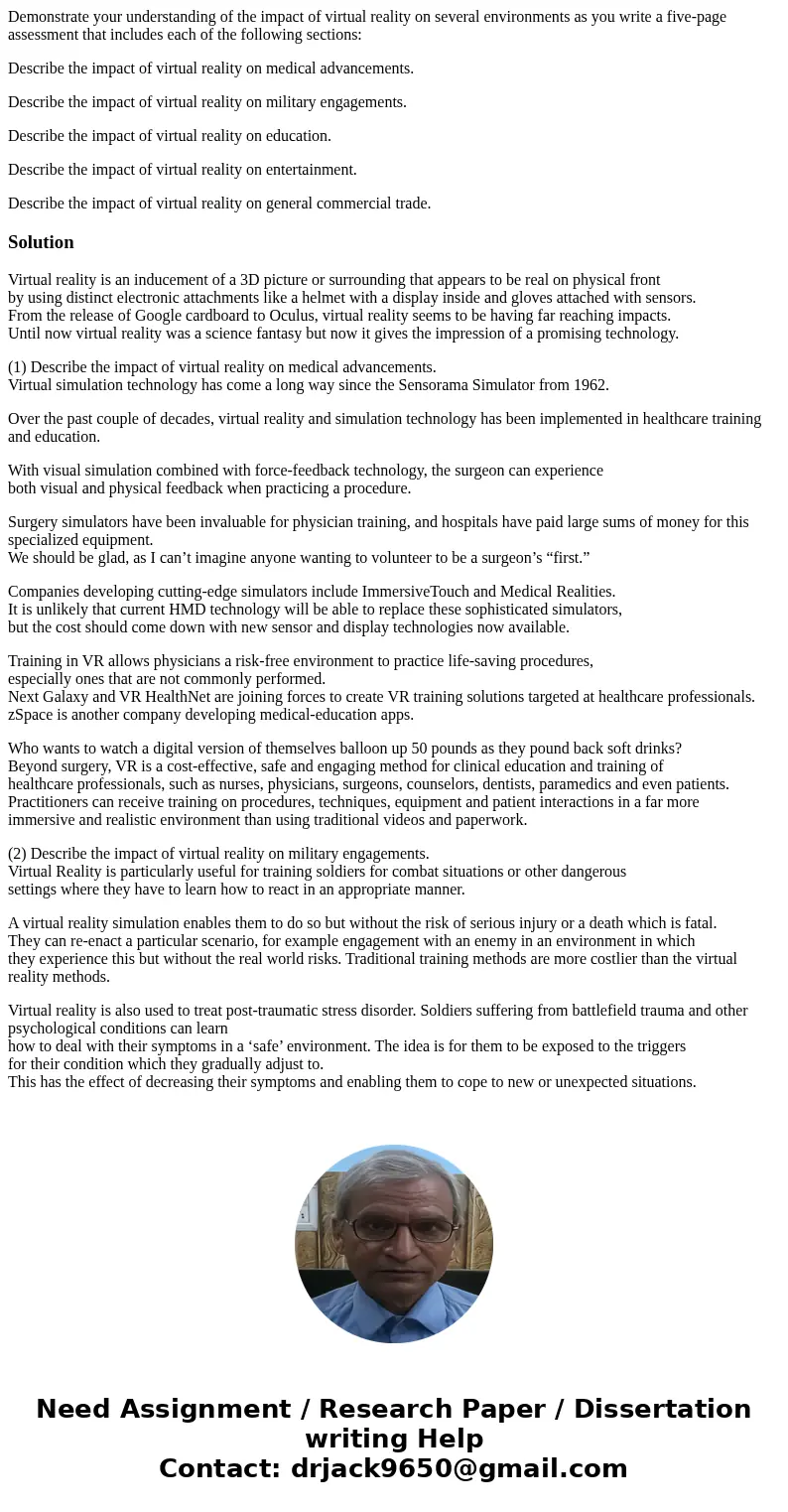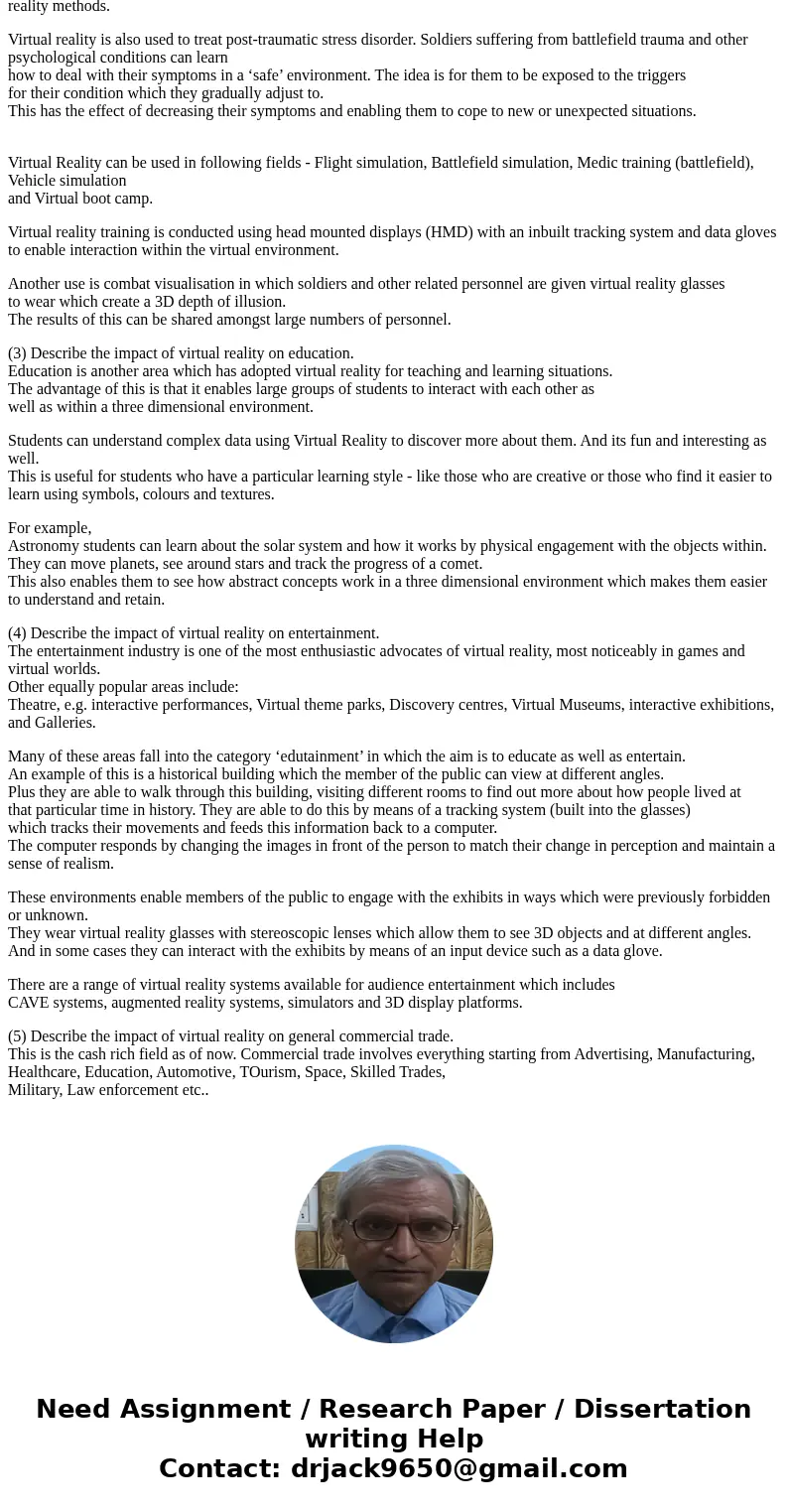Demonstrate your understanding of the impact of virtual real
Demonstrate your understanding of the impact of virtual reality on several environments as you write a five-page assessment that includes each of the following sections:
Describe the impact of virtual reality on medical advancements.
Describe the impact of virtual reality on military engagements.
Describe the impact of virtual reality on education.
Describe the impact of virtual reality on entertainment.
Describe the impact of virtual reality on general commercial trade.
Solution
Virtual reality is an inducement of a 3D picture or surrounding that appears to be real on physical front
by using distinct electronic attachments like a helmet with a display inside and gloves attached with sensors.
From the release of Google cardboard to Oculus, virtual reality seems to be having far reaching impacts.
Until now virtual reality was a science fantasy but now it gives the impression of a promising technology.
(1) Describe the impact of virtual reality on medical advancements.
Virtual simulation technology has come a long way since the Sensorama Simulator from 1962.
Over the past couple of decades, virtual reality and simulation technology has been implemented in healthcare training and education.
With visual simulation combined with force-feedback technology, the surgeon can experience
both visual and physical feedback when practicing a procedure.
Surgery simulators have been invaluable for physician training, and hospitals have paid large sums of money for this specialized equipment.
We should be glad, as I can’t imagine anyone wanting to volunteer to be a surgeon’s “first.”
Companies developing cutting-edge simulators include ImmersiveTouch and Medical Realities.
It is unlikely that current HMD technology will be able to replace these sophisticated simulators,
but the cost should come down with new sensor and display technologies now available.
Training in VR allows physicians a risk-free environment to practice life-saving procedures,
especially ones that are not commonly performed.
Next Galaxy and VR HealthNet are joining forces to create VR training solutions targeted at healthcare professionals.
zSpace is another company developing medical-education apps.
Who wants to watch a digital version of themselves balloon up 50 pounds as they pound back soft drinks?
Beyond surgery, VR is a cost-effective, safe and engaging method for clinical education and training of
healthcare professionals, such as nurses, physicians, surgeons, counselors, dentists, paramedics and even patients.
Practitioners can receive training on procedures, techniques, equipment and patient interactions in a far more
immersive and realistic environment than using traditional videos and paperwork.
(2) Describe the impact of virtual reality on military engagements.
Virtual Reality is particularly useful for training soldiers for combat situations or other dangerous
settings where they have to learn how to react in an appropriate manner.
A virtual reality simulation enables them to do so but without the risk of serious injury or a death which is fatal.
They can re-enact a particular scenario, for example engagement with an enemy in an environment in which
they experience this but without the real world risks. Traditional training methods are more costlier than the virtual reality methods.
Virtual reality is also used to treat post-traumatic stress disorder. Soldiers suffering from battlefield trauma and other psychological conditions can learn
how to deal with their symptoms in a ‘safe’ environment. The idea is for them to be exposed to the triggers
for their condition which they gradually adjust to.
This has the effect of decreasing their symptoms and enabling them to cope to new or unexpected situations.
Virtual Reality can be used in following fields - Flight simulation, Battlefield simulation, Medic training (battlefield), Vehicle simulation
and Virtual boot camp.
Virtual reality training is conducted using head mounted displays (HMD) with an inbuilt tracking system and data gloves to enable interaction within the virtual environment.
Another use is combat visualisation in which soldiers and other related personnel are given virtual reality glasses
to wear which create a 3D depth of illusion.
The results of this can be shared amongst large numbers of personnel.
(3) Describe the impact of virtual reality on education.
Education is another area which has adopted virtual reality for teaching and learning situations.
The advantage of this is that it enables large groups of students to interact with each other as
well as within a three dimensional environment.
Students can understand complex data using Virtual Reality to discover more about them. And its fun and interesting as well.
This is useful for students who have a particular learning style - like those who are creative or those who find it easier to learn using symbols, colours and textures.
For example,
Astronomy students can learn about the solar system and how it works by physical engagement with the objects within.
They can move planets, see around stars and track the progress of a comet.
This also enables them to see how abstract concepts work in a three dimensional environment which makes them easier to understand and retain.
(4) Describe the impact of virtual reality on entertainment.
The entertainment industry is one of the most enthusiastic advocates of virtual reality, most noticeably in games and virtual worlds.
Other equally popular areas include:
Theatre, e.g. interactive performances, Virtual theme parks, Discovery centres, Virtual Museums, interactive exhibitions, and Galleries.
Many of these areas fall into the category ‘edutainment’ in which the aim is to educate as well as entertain.
An example of this is a historical building which the member of the public can view at different angles.
Plus they are able to walk through this building, visiting different rooms to find out more about how people lived at
that particular time in history. They are able to do this by means of a tracking system (built into the glasses)
which tracks their movements and feeds this information back to a computer.
The computer responds by changing the images in front of the person to match their change in perception and maintain a sense of realism.
These environments enable members of the public to engage with the exhibits in ways which were previously forbidden or unknown.
They wear virtual reality glasses with stereoscopic lenses which allow them to see 3D objects and at different angles.
And in some cases they can interact with the exhibits by means of an input device such as a data glove.
There are a range of virtual reality systems available for audience entertainment which includes
CAVE systems, augmented reality systems, simulators and 3D display platforms.
(5) Describe the impact of virtual reality on general commercial trade.
This is the cash rich field as of now. Commercial trade involves everything starting from Advertising, Manufacturing, Healthcare, Education, Automotive, TOurism, Space, Skilled Trades,
Military, Law enforcement etc..


 Homework Sourse
Homework Sourse